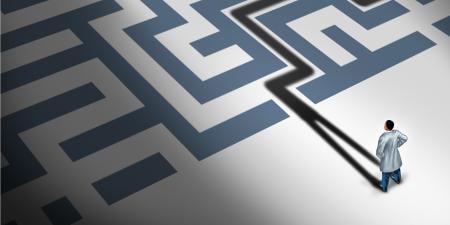Dr. Burke, a primary care physician, is seeing Mrs. Carter during a return visit to evaluate a new medication and exercise regimen she has recommended for Mrs. Carter’s osteoarthritis of the knee. Mrs. Carter is very pleased and mentions that she is now able to work in her garden again.
Dr. Burke uses a version of the electronic medical record (EMR) that facilitates narrative notes in addition to check-off options. She adds the comment, “Able to work in garden again,” to her progress note for the visit.
On the next visit, Dr. Burke reviews her previous note and asks Mrs. Carter at the beginning of the session, “And how is your garden coming along?” Mrs. Carter is pleased that the doctor remembered her favorite hobby.
Dr. Gold, another primary care physician, has an identical encounter with his own osteoarthritis patient, Mrs. Carter. The form of EMR he uses makes it very complicated to add narrative notes and favors check-off boxes. He clicks on the box, “Joint function: improved.”
During the next follow-up visit, Dr. Gold cannot remember whether it was Mrs. Carter or one of his other patients who liked to garden. He decides to play safe and not bring up the subject.
EMR’s Impact
Most experts are enthusiastic about the potential of the EMR to improve quality of care and reduce costs. What impact will the EMR have on the patient-physician relationship? As the above hypothetical and anecdotal cases study suggest, that depends.
I am simplifying greatly in suggesting that there is such a thing as thepatient-physician relationship that might be altered by new developments. Different models for the relationship have been proposed and debated [1]. For this discussion I am assuming that the “traditional” relationship has three important elements—first, the patient’s awareness of the physician’s fiduciary duty to serve the patient’s health-related interests; second, the patient’s sense of being treated as a unique person and not simply as a case of medical disease; and finally, an openness to active give-and-take, with patients participating in therapeutic decisions to the extent that they wish.
The EMR is only one of a series of innovations that promise to affect the patient-physician relationship in ways that may be without precedent. The field of bioethics has always shown a great interest in anticipating the ethical consequences of new medical technologies—from organ transplantation and mechanical ventilation, to stem cells and nanoparticles. The field has shown less proclivity for investigating new forms of personal and social relationships [2].
Bioethics’ neglect of relationships may mirror its lack of interest in primary-care issues. Subspecialty practice often defines itself in terms of its technological tools. Primary-care practice defines itself in terms of the relationship, with the patient at its core. Thus, continuity of care and personalized care are definitive features of primary care.
It is past time to be exploring the impact recent innovations are likely to have on the relationship. One way of focusing the discussion is to look at the idea of the “medical home” and pay-for-performance (P4P).
The Medical Home
Developed in pediatrics as a model for caring for special-needs children, the medical-home concept has now been embraced in family medicine and general internal medicine and has caught the interest of health policy analysts [3]. The enthusiasm is driven by the realization that most patients suffer from one or more chronic illnesses, and the U.S. system does a poor job of managing those patients and their illnesses. The medical home promises a number of features that could help the system do a better job.
- Patient-centered care, such as same-day scheduling and ease of access by telephone, e-mail, and Internet.
- EMR and aggressive quality monitoring.
- Interdisciplinary team care.
- Coordination of care, whether delivered on-site or referred outside.
- Focus on prevention and health education, including group visits.
These components should not obscure the basic idea of the medical home. Home is a place in which we feel welcomed. If patients do not experience a welcoming environment when they arrive, the other features, however impressive, will not accomplish what is needed.
If the medical-home concept develops as now envisioned, patients will find themselves experiencing an ongoing personal relationship with, not one individual, but a facility and team of individuals. Because coordinated team care seems to offer so many advantages for dealing effectively with the demands of preventive medicine for chronic illnesses, we hope that this transition will be a net plus for the patient. Whether it will or not, and what the specific gains and losses might be, will require careful study and monitoring. We can readily imagine how transferring allegiance from a primary physician to a care team and clinic facility could lead to a diminished sense of a personal relationship. There are, however, important opportunities for expanding the notion of relationship that also ought to be factored in and studied.
Consider the idea of group visits—a group of patients with diabetes meet monthly to discuss topics like diet, exercise, and foot care with the physician, nurse, or nutritionist. These patients supplement the relationship with their physicians and other team members with the interactions among a group of other patients suffering from the same condition. At group visit meetings, they share tips that each has learned about self-management of diabetes and provide mutual emotional support and encouragement. Social support of this kind can itself be a factor in improving health outcomes, along with advice and encouragement the patient receives regarding diabetes.
Finally, the ideal medical home will exist in a relationship with the community in addition to its individual relationships with patients. If the medical home follows the model of one of the most successful types of primary care facility—the federally qualified community health center—it will have a community advisory board to help ensure that the voice of community representatives is heard and the health needs of the community are understood, through the eyes of its members. The medical home that pursues this model will be a public health facility as well as an individual-care facility, responsive to its patients’ needs at all levels.
In sum, the medical home threatens the traditional patient-physician relationship in some ways but also offers to deepen and expand it. What about another policy innovation—pay-for-performance (P4P)?
Pay-for-Performance
It has been difficult to find any policymaker willing to say anything bad about P4P because at first blush it sounds like the ideal solution to the age-old problem—how can I pay my physician when, and only when, he or she does something that benefits my health? The advent of so-called evidence-based practice guidelines holds out the promise that we can measure quality care precisely. If we then tie reimbursement to guideline adherence, perhaps we have finally reached the economic nirvana.
Sadly, the reality falls rather short of the ideal. The actual evidence regarding P4P, and the degree to which practice guidelines actually reflect the best available evidence, is rather discouraging [4].
It is relatively easy to measure the percentage of diabetic patients for whom the physician has ordered a glycohemoglobin level test in the last 12 months. It is much more difficult to measure the components of the patient-physician encounter that go toward creating and sustaining a personal relationship. In all such cases, the measurable usually drives out the important. When physicians are paid a lot for doing discrete, technical procedures and very little for spending time with and talking to patients, we have the sort of health system we have today, which is long on procedures and short on meaningful relationships.
Society values both the appropriate use of new technological and management innovations and the maintenance of a strong personal and therapeutic relationship between patients and physicians. My recommendations are to embrace the medical-home model but be wary of P4P [2]. In each case much more evidence will be required to determine real outcomes and discover whether either the promise or the peril has been realized in practice.
References
- Emanuel EJ, Emanuel LL. Four models of the physician-patient relationship. JAMA. 1992;267(16):2221-2226.
-
Brody HA. The Future of Bioethics. New York, NY: Oxford University Press; 2009.
- Martin JC, Avant RF, Bowman MA, et al. The future of family medicine: a collaborative project of the family medicine community. Ann Fam Med. 2004;S Suppl 1S3-S32.
- Auerbach AD, Landefeld CS, Shojania KG. The tension between needing to improve care and knowing how to do it. N Engl J Med. 2007;357(6):608-613.



